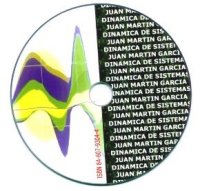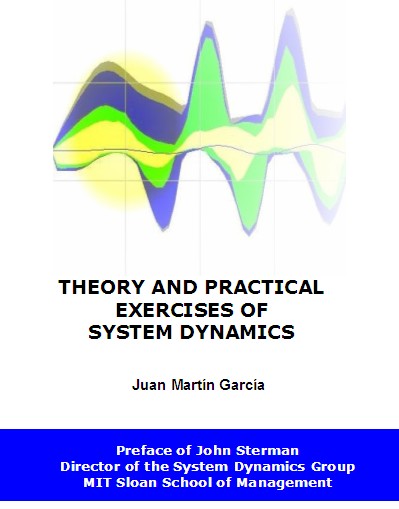



| |
COURSE DOCUMENTATION
Contents
1. Introduction to Ecology
2. Complex systems
3. Model construction
4. Cases
- Simple system. Population Dynamics.
- Stable system. Ecology of a nature reserve.
- Unstable system. Effects of intensive agriculture.
- Oscillating system. Livestock policy.
5. Appendices
- Selected case studies
- Bibliography and references
- Employment Offers
 1. Introduction to Ecology
1. Introduction to Ecology 2. System Dynamics
2. System Dynamics 4. Cases
4. Cases 4.1. Introduction: Population dynamics
Goal 1. Installation and use of the basic features of the software.It is the first case study performed on the computer by the student, who is shown through the stages step by step. Before carrying this out, it is advisable for the student to illustrate the system's possible development on paper. Once designed, the model can carry out various simulations in order to monitor its sensitivity to different parameters. The software is not difficult to use, and this first model allows us to become acquainted with its primary characteristics. Man is very good at perceiving reality, and computers are good at showing the development of a system that has a large number of relationships between its elements. The student discovers that the difficulty lies not in using the software, but in perceiving reality clearly.
Goal 2. To determine possible and impossible behavior. The model structure already provides information, before carrying out any simulation, about the kind of behavior we can expect: stable, unstable, oscillating and other behaviors.
4.2. Simple system: Dynamics of a diposit.
Goal 3. To compare intuitive behavior with the model's results. Our intuition is of great use throughout our lives. But intuition is based on experience. This model allows students to compare the development they expected, based on intuition, with the one provided by the computer according to the parameters established.
4.3. Stable system: Ecology of a nature reserve.
Goal 4. To learn how to turn a literary text into a formal model.A model is an efficient simplification of reality. On many occasions our view of reality is determined by texts or reports produced by specialists. This case study aims to accustom students to this "translation" of an almost allegorical text into something much more concrete: a simulation model. In this case, the system, a nature reserve, is manipulated beyond stability by man and we observe its return to normality, as well as the possible effect of the improvements that the students may propose. Goal 5. Constructing a model in stages. One way of constructing models is in successive stages, each more extensive than the last, until one obtains a view of reality that is sufficiently accurate to allow decision making. This exercise consists of making a three-stage model on the computer, the first of which has a stable behavior. The second purposely destabilizes itself and for the third, which collapses, the student is asked to simulate various alternatives.
Goal 6. To simulate various management policies. Students are first expected to reproduce the model, that is, to follow the set path. When the final version has been reached, students are expected to make changes to the model, or simulations that allow them to consider and justify different courses of action.
Goal 7. The use of nonlinear relationship tables. The tables are an efficient tool for modelling relationships amongst elements when they are very complex, and there is no simple arithmetical relationship that might describe them. 4.4. Unstable system: Effects of intensive agriculture.
The point is to reproduce an unstable system on the computer, despite the fact it seems stable in the short term, until it reaches breaking point. Students are expected to simulate various changes in the model's structure that will provide greater stability in the long term. Goal 8. The importance of the Simulation Horizon. Each model has a purpose, which is defined by time. It is necessary to choose an appropriate time scale in order to attain an accurate view of the effects of our actions on reality. Goal 9. Studies in poorly defined environments. Access to all the desirable quantitative data is not always possible, although this does not prevent the drafting of valid alternatives. Goal 10. Units of measurement help us. In systems of a certain complexity, evaluating the coherence of the units of measurement used to define the system's elements can help us to evaluate the model as a whole. Goal 11. Breaking points without alarms. This is a good exercise for observing real life situations where an abrupt change occurs in a model's status, without prior warning or indications.
4.5. Oscillating system: Livestock policy.
Goal 12. The integration of sub-models. Constructing models based on the integration of various sub-models is standard practice when various disciplines are involved. This case study serves to familiarize oneself with this technique. This model is approached by first creating two sub-models with a stable behavior which have parameters that will later allow them to be merged into one. Goal 13. Using Time Lag Functions. On many occasions there is a long time lag between a cause and the effects that it has. In order to be of use, models must take this phenomenon into account. Goal 14. The study of oscillations. Models which have only one level and no time lag cannot have oscillations. In all other cases, more or less visible oscillations appear. The models help us study them. Final Goal. Explanation of results. The complexity of reality makes it difficult to explain clearly. Models can help us present our view of reality visually. Once this has been achieved, it is possible to present and discuss our suggestions for improvement
5.1. Selected worksThe bulk of the appendices consists of more than 250 pieces of work and articles on this methodology, around 1,500 pages on CD-ROM, so students can study any aspects of the course they wish in further depth.
5.2. Bibliography and ReferencesA bibliography and a description of the software that may exist on the market are attached.
5.3. Employment Offers
Also attached are various recent Employment Offers from consultancy firms.
 In addition, the modelling and simulation software package VENSIM PLE is provided on CD-ROM along with demos of other very similar pieces of software like ITHINK and STELLA.
In addition, the modelling and simulation software package VENSIM PLE is provided on CD-ROM along with demos of other very similar pieces of software like ITHINK and STELLA.RECOMMENDED BIBLIOGRAPHY

Theory and Practical Exercises of System Dynamics. ISBN 84-609-9804-5 See the book